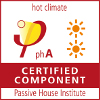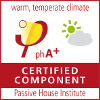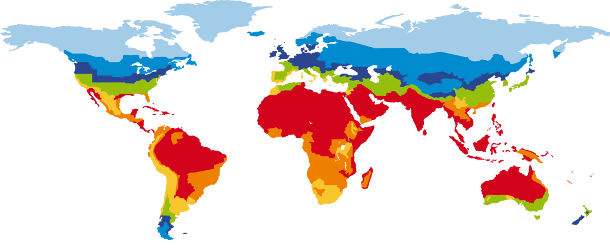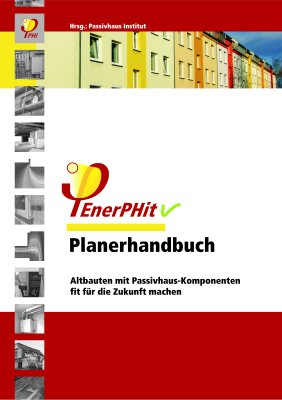Certification criteria for Passive House Transparent Building Components
| Transparent components ( |
|
Windows in a step-by-step retrofit ( |
| Insulated Glass Units and Solar Protection Glazing ( |
|
|
| Sun Protection and Window Installation Systems ( |
|
Transparent component seals |
The Passive House Institute (PHI) has introduced efficiency classes for windows and other transparent building components in order to help set highly energy efficient products apart at a glance. The efficiency classes are based on heat losses through the frame and glass edge of the window. For good efficiency ratings windows should have low frame U-values, low glass edge thermal bridge losses and narrow frames to allow high solar gains from large glass surfaces. This scale is also useful in cool climates because a minimized frame, with the same glass surface and the same U-values reduces the cooling load. |
 |
The many climates of the earth put different demands on passive house components. The PHI has identified seven climatic regions and defined requirements for each. The suitability of a component for a climate region is shown by a combination of climate pictograms on a component seal. A snowflake stands for "cold", a sun for "warm" and a cloud for "warm - temperate". A combination of three suns is, for example "very hot". (See climate icons legend). All the technologies and components needed to design and build a window for cold climate regions are already available on the market. Two such window studies were introduced at the 2012 |
 |
|
 |
|
Climate icon legend |
|
| Arctic |
|
| Cold | |
| Cool, temperate | |
| Warm, temperate | |
| Warm | |
| Hot |
|
| Very hot | |
The map below shows the various climate regions for Certified Passive House Windows. From the map, it is clear that triple-paned windows dominate in the cool, temperate and very hot and humid climates, although in the latter with an additional layer of sun protection. Double-paned windows, however, play a subordinate role. Quadruple-paned glazing will have an increasingly important role to play in "arctic" regions and cold climates. It is important to note, however, that the arctic regions, for which there is not yet any truly adequate glazing available, are very sparsely populated - such windows are thus significantly less important worldwide than the map below would have it seem. |
|
 |
|
Climate map legend |
|
| Arctic | |
| Cold | |
| Cool, temperate | |
| Warm, temperate | |
| Warm | |
Hot |
|
| Very hot | |
| Next Courses |
PHPP Expert
Passive House Designer / Consultant
Construction Verifier
Site Supervisor
![]() read more
read more
e-learning
| Events |
iPHA Webinar "Project Spotlight: The CLT 8-floor ANMF hotel in Melbourne, Australia with heritage overlay." | November 12, 2025
![]() read more
read more
![]() Passive House Open Days |
Passive House Open Days |
7 - 9 November 2025
![]() read more
read more
![]() 24 - 25 April 2026, Essen, Germany
24 - 25 April 2026, Essen, Germany
![]() read more
read more
| Component Database |
 Passive House
Passive House
Component Database
read more
| Projects |
| New developments |
![]() designPH
designPH
read more
![]() NEW: PHPP 10 (2021)
NEW: PHPP 10 (2021)
read more
 Seals for Certified Passive House Components
Seals for Certified Passive House Components
read more
 Passive House Classes,
Passive House Classes,
Classic, Plus, Premium
read more
 EnerPHit -
EnerPHit -
PHI certification for retrofits
read more
 Wall plaque
Wall plaque
for certified Passive Houses
read more
| Press releases |
| Research & Literature |
![]() Passive Houses for different climate zones
Passive Houses for different climate zones
more
 Retrofits with Passive House components -
Retrofits with Passive House components -
EnerPHit Planner Handbook
(in German)
 Passive House Retail Stores now out
Passive House Retail Stores now out
Overview of contents
(in German)


